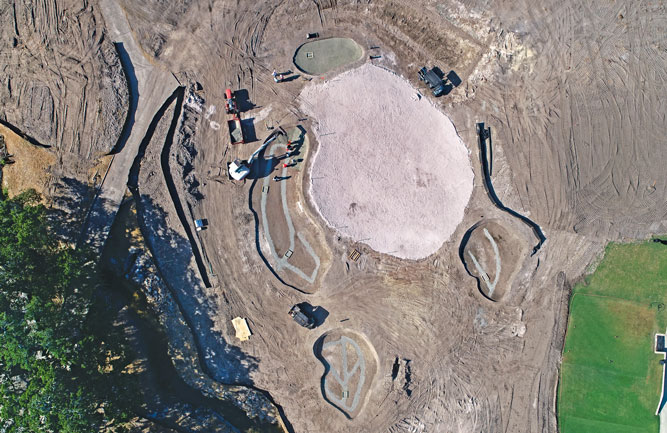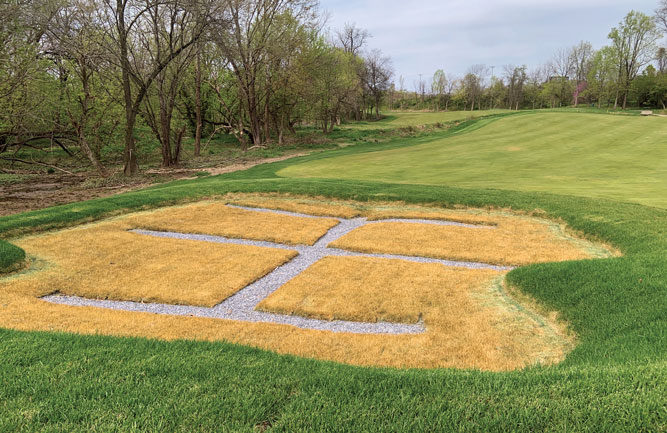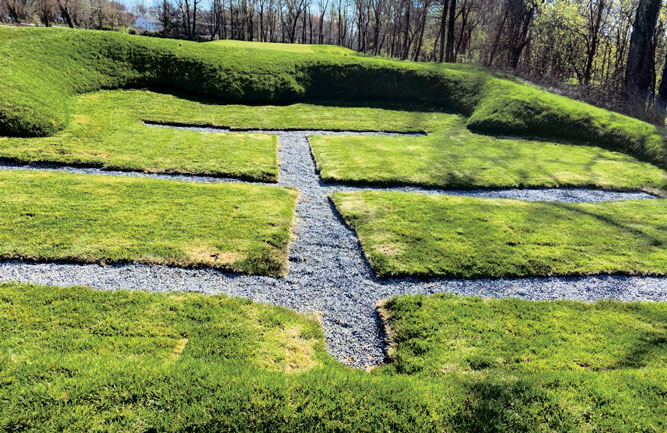The best bunker minds in the business talk trends in maintenance, restoration and renovation

Brookside Country Club. (Photo: David Dale)
Want to get a rise out of someone in the golf maintenance industry? Start talking bunkers.
So much time, money, effort and artistry go into maintaining 18 holes of greens, tees and fairways. The same goes for bunkers, but add in a few more emotions, like angst, agony and maybe even anger.
“It’s a topic of so much scrutiny, especially among the private course contingent,” says Bryce Swanson, ASGCA, Rees Jones Inc. “When we were kids, if you got a fried-egg lie, you learned how to play the shot. Nowadays, the notion of having a fried egg? For everyone, that ship has sailed.”
Golfdom interviewed architects and superintendents around the country to learn the most current buzz on bunker maintenance.
Reduction and relocation
Golfplan — Dale & Ramsey Golf Course Architecture has completed more than 200 courses around the world since 1972. David Dale, principal, says these last few years, Golfplan has seen a tremendous amount of bunker-focused work. It primarily falls into one of two categories, and sometimes both: reduction and relocation.
Their project at Brookside CC in Northern California falls in line with this theme. When the course opened in 1991, it had 73 bunkers. Thanks to Golfplan’s work, it now has 64, and they’re smaller in size.
The course had 37 greenside bunkers with a combined square footage of 56,240 square feet. Now it has 32 greenside bunkers with a combined square footage of 27,300. That’s only five fewer bunkers but a whopping 51-percent reduction in area. The courses’ 36 fairway bunkers have been reduced to 32, while the total square footage dropped from 73,300 square feet to 46,285, a 37-percent reduction. The combined total area reduction is 44 percent.
“With (golf club) technology where it’s at today, many of these bunkers were just out of position now,” Dale says. “Plus, that’s a lot of sand for the club to try to maintain.”
Dale adds that their international work was already heavy on bunker reductions, citing a course in Japan struggling with 130 bunkers. The reduction and relocation of bunkers brings a lot of work to Golfplan domestically, as well.

Brookside CC reduced its overall bunkers from 73 to 64 with a reduction in size, too. Architect David Dale says the reduction in bunkers combined for a total of 44 percent less square footage in bunkers. (Photo: David Dale)
“It’s good for business, but at the same time, it’s really taxing on these clubs to try to come up with sand replacement every seven years, as that’s about the typical life cycle of a bunker,” he says. “You get sands that are contaminated, and they have to replace it — that’s extremely expensive. It gets to the point that the club asks, ‘What are we going to do? We can’t afford this so frequently.’ The logical thing is to reduce.”
Ease of entering and exiting bunkers has also been a topic of discussion at the courses Golfplan works with. Dale welcomes this challenge because he says making bunkers easier to enter and exit is good for golfers as well as maintenance crews.

Many courses, like Brookside CC, are opting to remove bunkers to save on labor and materials, says architect David Dale. (Photo: David Dale)
Sealed its fate
The West Course at Belleair CC, Florida’s first golf course, recently underwent a full restoration to Donald Ross’ original drawings, with plans to address the East Course in the next few years. Superintendent Andy Neiswender says he made a big push to address the course’s bunkers with the renovation.

Belleair CC during the West Course renovation. Belleair restored the course to the original Donald Ross design. (Photo: Belleair CC)
He says prior to the renovation, it could take up to 350 hours to get the East and West bunkers back into play. But the moment that sealed the bunkers’ fate — literally — came in the form of a major rain event on the day of Belleair’s member/guest tournament.
“We were in really good shape, and we had a 2-inch rainfall the morning of the start of that event. It completely washed out the bunkers on both courses,” he says. “We had no way of getting them playable before the event started, so the event had to play them as ground under repair.”
He says the washout helped his membership understand the value of adding bunker liners.
“I explained to the membership, (we) spent almost the same amount of money per square foot on bunkers as we do on greens,” he says.
With the renovation of the West Course, Neiswender says Fry/Straka Global Golf Course Design removed about 1,000 trees and moved around 220,000 cubic yards of material.
“When the members came out, there was nothing that looked anything like the old golf course,” he says.

Belleair CC’s moat bunker is one of the original Donald Ross design elements restored with the West Course renovation. (Photo: Belleair CC)
Located next to the Intercoastal Waterway in Clearwater, Neiswender says the course is prone to wind issues with incoming fronts, which can impact the new bunkers with severe slopes.
“On a windy day, some of these faces are so high that the wind dries them out and just carries the sand on, and we lose some of the sand on the faces,” he says.
He says he’s been impressed with how the course’s Capillary Concrete liners helped mitigate issues from storms.
“We’ve had a couple of good rain events on them, and we’ve had very little issues with anything washing out,” he says.
One interesting feature of the new design is the restoration of a moat bunker. Connor Lewis, founder of the Society of Golf Historians, lobbied the membership to keep the moat design.
“The members really can only access the back corner of the green or they have to walk through the bunker,” he says. “So, by about 9 in the morning, we have about 20 rakes all lined up on the front of the green where they’ve walked through the bunker with a rake and then left it on the front of the green.”
Neiswender says the course plans to add a walkthrough like Ross added in his 1924 design revisions, although this time with Kafka Granite, “so it still kind of looks like a bunker, but they can walk through it.”

Tyler Rae (Photo: Tyler Rae)
Sod bottoms
It’s been a busy time for architect Tyler Rae, as his massive project at Lookout Mountain (Ga.) Club is about to open for the 2023 season. He hopes that the project garners national attention in the industry. There’s also his ongoing work at Detroit Golf Club, home of the Rocket Mortgage Classic; a rerouting and reconstruction of Chicago’s Northmoor CC and following the conclusion of the Principal Charity Classic, a multimillion-dollar project at Wakonda Club in Des Moines, Iowa, among others.
When it comes to bunker work, Rae has seen just about everything in his 18-year career. It would get monotonous, he says, to stick to one style. Even Donald Ross had six different styles of bunkers. Rae describes himself as an amphibian — able to adapt to any conditions.
He also says he loves building different styles of bunkers from project to project depending on the location, soil makeup and typical weather patterns. That also applies to when a course wants to save a few dollars on any given aspect of a project.

A post-herbicide treatment of a sod bunker liner during the installation process. Sod knits in before crews apply the herbicide treatment. (Photo: Tyler Rae)
Rae also points to an opportunity he’s seen in the industry when design allows it: grass or sod liners in bunkers.
“If we’re restoring a Donald Ross or a Seth Raynor (course) with bunkers that are primarily a bit flatter-bottomed without a big sand-flashed face, where the sand won’t migrate after a heavy rain event, we’re going to suggest the potential of grass liners,” Rae says. “They keep the rocks, pebbles and drainage gravel from contaminating the sand. Once the sod knits in, it creates a seamless, carpet-like bottom. Beware though, if you have a high sand flash like Augusta National, this technique likely won’t work.”
Rae says they lay the sod, let it knit in, mow it once, then spray it with glyphosate. He’s seen these bunkers last 10 to 13 years, but at one-eighth of the cost. He says it was superintendents who created the idea, with Rich Shilling at Jeffersonville GC near Philadelphia being among the first, and Doug Larson at the Shore Club in New Jersey, Chris Donadio at Woodland GC near Boston and most recently John Ruzsbatzky, CGCS, at Wampanoag CC all seeing success.
Rae adds that there are several bunker liner technologies that he likes to employ and has seen success with many of them.

Sod liners give bunkers extra life at a fraction of the cost of other bunker liners, says architect Tyler Rae. (Photo: Tyler Rae)
He’s recently added a new style to his own bunker repertoire. He describes it as having a 6- to 7-foot sand flash with a 20-inch lip. It creates dramatic shadowing in the afternoons.
“That might be my favorite style yet,” Rae says. “The new liners allow us to be bold with our designs. It’s exciting to see what other architects are designing, too. There’s a lot of fantastic work right now from some talented architects.”
A free drop and a refocus
The bunkers at Cottonwood Creek CC in Waco, Texas, are an anomaly. Built in 1984 and clocking almost 40 years in play, superintendent JD Franz says they’re “consistently average.”
Having almost 40-year-old bunkers comes with its challenges. Crews replace any crushed irrigation pipe and add sand. His steep slopes can get fried eggs. When Franz started at Cottonwood in 1997, the course planned to renovate the bunkers, but over the years, management pushed it to the back burner.
Crews mechanically rake the bunkers seven days a week. When the original management company installed the bunkers, the installation started with a small layer of cement and sand on top. And when sand, cement and water from rain mix, it makes concrete.
“For the first 10 years, every day you would have a 5-gallon bucket on the Sand Pro filled with concrete chunks,” he says.
Cottonwood sits on alkaline soil. Bunkers in clay soils often get what Franz says his former boss called “a soup dish,” but he speculates the concrete may keep that from happening at Cottonwood so far.
“I’d say the concrete’s probably half there, but it could be that’s why they haven’t silted over at the same time,” he says.
Pace of play is a huge concern at Cottonwood. Franz estimates golfers played around 45,000 rounds last year, so he says it’s important to toe the line with bunkers.
“We don’t want to raise the heights so much that they have a hard time,” he says. “But at the end of the day, it is a hazard.”
Franz says bunkers require so much labor, especially after rain. He’s changed his strategies following rain events to deploy one crew member with a pump and one following with a mechanical rake.
“I just sent two people all day for 8 to 10 hours, and they’ll be done in two days,” he says. “With half an inch of rain, I used to go out there and send a guy to pump it. Now I tell (the golfer), to take a free drop for a day. There’s going to be a little water in the bottom, and then they’ll be dry tomorrow.”
He says this allowed him to focus on the whole course instead of devoting so much time to bunkers.
“The whole entire golf course is maintained better now, not just the bunkers,” he says. “We’re stretched too thin to be putting half the crew on the bunkers.”
What they say, what they want
The team at Rees Jones Inc., of Rees Jones, Greg Muirhead, Steve Weisser and Swanson combined for nearly 150 years of experience in golf course design, construction and project management. Jones is happy to report that business is good, with projects on tap around the world and a recent spike in demand in southern Florida.
He adds with a laugh, “that only happens when you’re good.”
Swanson spoke with Golfdom about the wishes of Rees Jones’ clients. He says bunkers are perhaps the most heavily scrutinized topic of any restoration or renovation because opinions still differ on what a bunker should be.
“People think that if you hit into a bunker, no matter what, you ought to be able to hit onto the green,” Swanson says. “Go over to Scotland. In some of those bunkers, you have to play out sideways. It’s not perfect. And some people say they kind of want that … but at the same time, they’re saying the opposite.”
Swanson echoes what others said: the number of bunkers is trending downward.
“In the early 2000s, it wasn’t unheard of to see maybe 200,000 square feet of bunkers going into places,” he says. “In the 1990s, the 2000s, everything was tied to selling real estate.”
With many courses putting a focus on sustainability, Swanson says this has an end benefit to the golfer.
“There’s more emphasis on finding balance in terms of playability and giving players an opportunity for a recovery shot,” he says.
Education and communication are key, he says. Whether a course wants a look like something they’d see at Augusta or in Australia, he communicates what that means for the golfer and the superintendent.
“There’s quite a bit of my time where I’m working with the superintendent and how these bunkers relate to the maintenance side of (the project),” he says. “Then there’s getting members to understand what it’s going to do on the back end as it relates to maintenance. If they want a sand flash all the way to the top, well, let’s discuss the pros and cons.”












